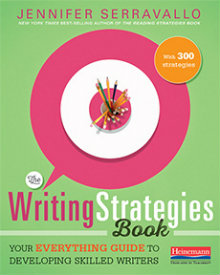Everything You Need to Develop Skilled Writers
The Writing Strategies Book: Your Everything Guide to Developing Skilled Writers
By Jennifer Serravallo
(Heinemann, 2017 – Learn more)

Sometimes, I am so excited about reading a book that I neglect or skim over the introduction. To be honest with you, I often feel like a hypocrite because I tell my students to make sure that they read the introduction to a book and pay attention to all text features. I am so glad that I finally practiced what I preach with The Writing Strategies Book.
I read the introduction and then reread it. The first time I read it for enjoyment (yes, enjoyment) and the second time I practiced close reading, noting my questions, wonderings, and useful applications for the classroom. Thirty-two pages full of information, inspiration, and implementation of writing strategies – just in the introduction. So:
Step 1: Make sure you read the introduction on the “Principles, Research, and Theory, and How to Use This Book.”
Step 2: Reread Step 1.
A Terrific Twin
When I first found out that Serravallo was working on The Writing Strategies Book, I kept checking Heinemann’s website to see when it would be published. I loved her “twin” book, The Reading Strategies Book: Your Everything Guide to Developing Skilled Readers. I’ve applied many of its strategies in my classroom and recommended the book to just about every literacy teacher I have met.

This structure is one of the reasons why it is critical to read the introduction. It lays out the framework for you. The format of each chapter is the same: the first few pages offer an overview of the goal, its importance, and whether it’s something you need for your students.
Goal 1: Composing with Pictures
Goal 2: Engagement: Independence, Increasing Volume, and Developing a Writing Identity
Goal 3: Generating and Collecting Ideas
Goal 4: Focus/Meaning
Goal 5: Organization and Structure
Goal 6: Elaborating
Goal 7: Word Choice
Goal 8: Conventions: Spelling and Letter Formation
Goal 9: Conventions: Grammar and Punctuation
Goal 10: Collaborating with Writing Partners and Clubs
A Comprehensive Take on Writing
Poetry, narrative, informational, and persuasive writing are all included. When I shared this book with a colleague, she literally jumped up and down with joy. Finding Language Arts conventions such as spelling, letter formation, grammar and punctuation also elicited her applause. No part of the writing process was left out.
I also love the book because all the lessons and resources are easily adaptable for differentiation in the literacy classroom. The premise is to meet students where they are and not to teach a skill in isolation or because it’s next on your curricular calendar.
Serravallo reminds us of many things, including giving ourselves and our students time. She stresses the importance of not jumping into a writing piece but giving students the opportunity to think, draw, think again, brainstorm, write.
She reminds us of the importance of sketching. Composing with pictures is not just drawing and coloring but a valuable way to develop and communicate ideas. Pictures and words support each other.
Servallo reminds us to assess our students’ needs and choose our lessons carefully – and take the time to go back, edit, and revise. She also reminds us of the beauty of writing.
Each lesson is an artistic creation with a teaching point. You’ll find “lesson language” to guide your instruction, suggested prompts to use with your students, the applicable level and genre, examples of anchor charts (quick to make and use), “Hat Tips”(additional resources) and teaching tips. That’s a lot to offer on just one page!
My artistic productions generally consist of stick figures. When it comes to making an anchor chart, I tend to leave the result hanging in the classroom and not in the hallway for public display. Serravallo’s anchor charts are works of art, but all you need is some confidence and markers that work. I have seen anchor charts in colleagues’ classrooms that should be part of a museum display, but the pictures distract from the message. If you follow Seravallo’s lead, even students who are just learning to read will be able to interpret the message and apply the strategy.
A Flexible Resource
Although you might be tempted to use every lesson in order and ASAP, this isn’t a book that you have to read cover to cover before you begin to mine its gold. The table of contents is easy to use and helps you target the instructional goals and strategies you can use for your students.
So, whether…
• You have students who can’t wait to put pen, pencil, or keyboard into action or you have reluctant writers…
• You have been implementing Writers Workshop in your class or you are just beginning to become more confident in creating a Writers Workshop…
• You are using a literacy program that you must follow…
• You are a novice teacher or a veteran teacher…
…this book is for you.
It’s a hefty book, all four hundred and ten pages worth! You might be tempted to take it with you on a trip to read, but be prepared with plenty of sticky notes, flags to mark pages, and a good backpack to carry it in.
Read Jennifer Serravallo’s MiddleWeb article:
5 Ideas to Make Writing More Fun to Teach
____________
Linda Biondi is a fourth grade teacher at Sharon Elementary School in Robbinsville, NJ and a long-time Morning Meeting practitioner. She’s also the recipient of several educational grants, a Teacher Consultant with the National Writing Project, and a participant on the NJ Department of Education Teacher Advisory Panel and with ECET2 Celebrate Teaching.






























